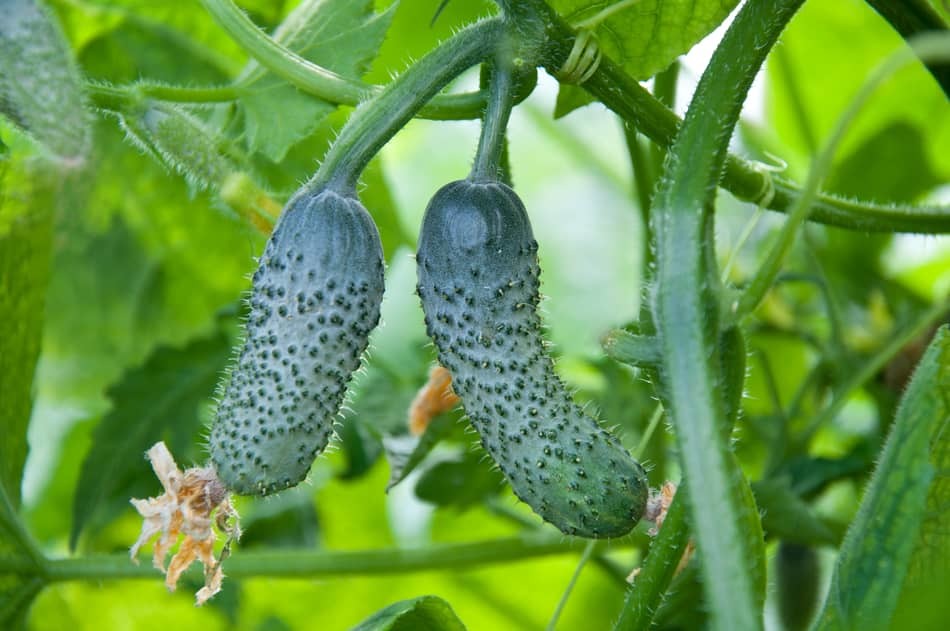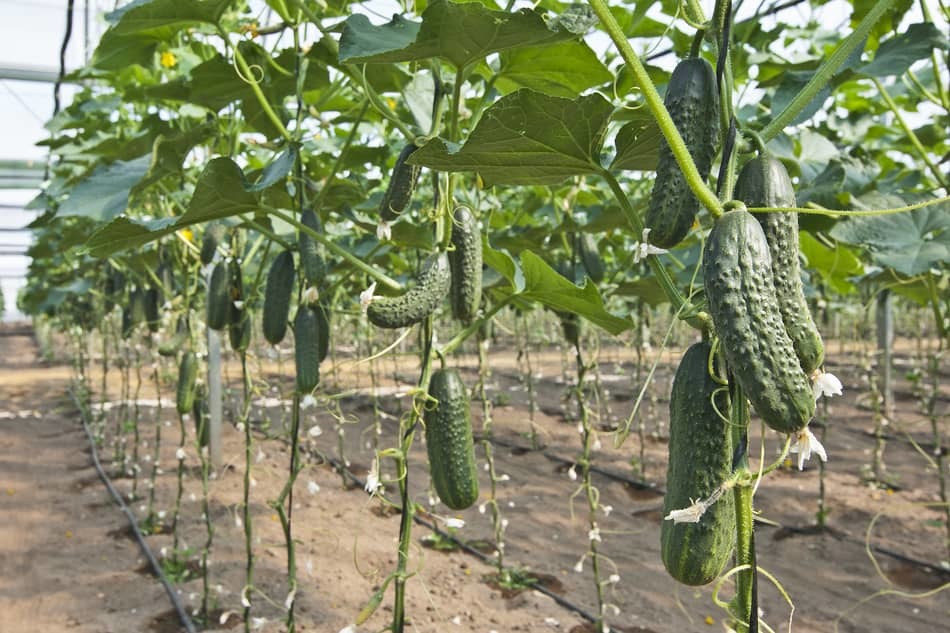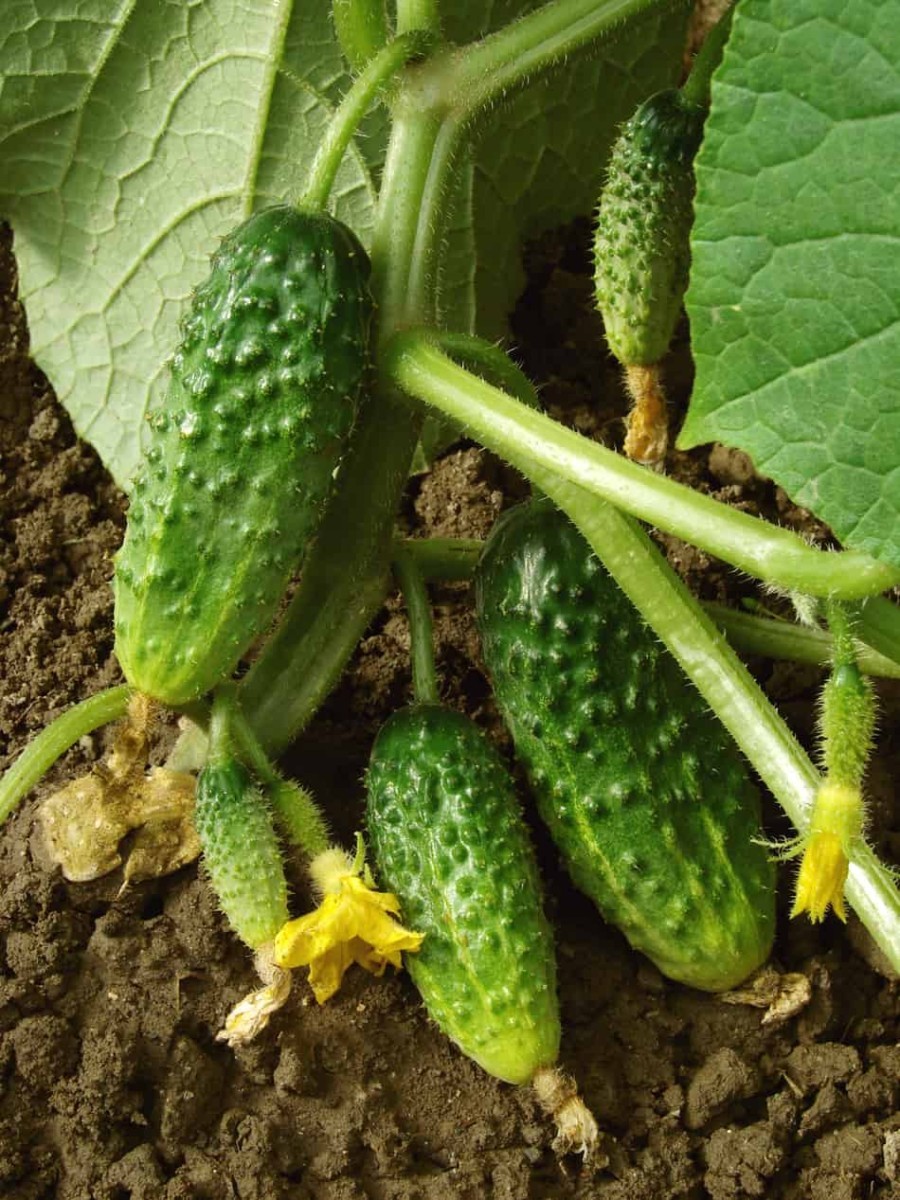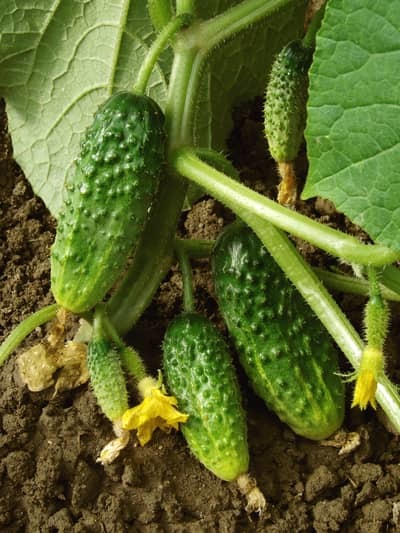Cucumbers are a unique species of plant in part because they’re easy to grow. Despite tasting delicious and being packed full of nutrients like potassium, magnesium, vitamin C, K, and A, they’re also low in calories and are can help hydrate you, since cucumbers are 95% water by weight.
Cucumbers take about 50 to 70 days from planting to harvest. However, that’s a general range, and will depend on the specific variety you plant, and growing conditions–for example, temperature, soil, fertilizer & nutrient availability, etc.
Cucumbers have the ability to grow from 3 to 24 inches when they are grown under optimal conditions. It’s important to plant the seedlings where they’ll receive sufficient sunlight. Seedlings should be thinned to 36 to 60 inches apart, and make sure to have warm fertile soil. For optimum growth, cucumbers prefer soil with pH that’s neutral to slightly alkaline, with a pH of 7.0- 7.6.
Many cucumbers produce both male and female flowers. Male flowers grow in clusters and open before the female. Female flowers grow on a single stem and are pollinated after insects visit the female flower first.

Where to start
Before you decide where to plant, make sure you select a planting site that has optimum sunlight.
It’s important to make sure the soil is neutral or slightly alkaline with a pH of 7.0 – 7.6.
Also, remember to plant seedlings to a depth of 36 to 60 inches apart–that way, the cucumber plants will have plenty of room to spread out as they’re growing.
Before you plant, the soil should be warm (at least 70 degrees Fahrenheit).
If you live in colder climates warm the soil first; covering the soil with black plastic works well to heat the soil.
- Cucumbers require consistent watering, and prefer slightly moist soil.
- Avoid touching the leaves of the plant to prevent leaf disease. Symptoms of leaf disease are brown or tan spots in various places on leaves.
- Get rid of any weeds in your cucumber patch and the area surrounding it. Weeds take the nutrients, water, and sunlight from your crops.
- Row covers are important. Use row covers to protect the plant from wind, cold, and heat. Row covers also have the ability to prevent the spread of disease.
See the 6 stages if the life cycle of cucumbers, & why they’re important.

Importance of Companion Planting
What are Companion Plants?
Companion planting simply refers to planting different species of plants near each other so that each species can benefit the other, often through pollination or pest control.
When plants grow into the soil, they take away nutrients, but many species can add nutrients back to the soil, which thus benefits surrounding plants.
Companion planting can also enhance the flavors of the vegetation being planted, can mask odors of certain plants, or repel insects that can harm your garden.
Companion planting is a good strategy to keep gardens thriving and healthy without pesticides.
It’s also important to remember that since many insects prefer specific plant species, you can reduce the insect pests mixing up & changing your crop locations.
Methods of Companion Planting
- Nurse Cropping:Nurse cropping is planting is a crop planted near another crop. This method of companion planting helps reduce the number of weeds that are grown nearby.
- Trap Cropping:Trap cropping is planting a crop next to your original crop to act as a decoy for pests to prevent harm to your original, more valuable crop.
Good Cucumber Companions
If you decide to plant any of these species next to your cucumbers, the benefits will be increased growth in cucumbers and less chance of disease.
- Radishes
- Asparagus
- Beans
- Corn
- Tomatoes
- Sunflowers
Bad Cucumber Companions
- Sage
- Potatoes: Planting cucumbers next to potatoes is not detrimental to your cucumbers but your potatoes. Cucumbers cause potato blight to form and will eventually damage the crop.
You should check out our full article on companion planting.

Common Problems Growing Cucumbers
Even though cucumbers are typically easy to grow, they still require maintenance. Below is a list of common problems that novice cucumber gardeners face.
Overwatering
Too much water can cause the roots of your plant to sit in damp soil, and prevents the plant from receiving necessary oxygen–basically, you can drown your plant.
Symptoms of overwatering:
- Leaf yellowing is a common sign of over watering your plant.
- Roof rotting: when roots are sitting in wet soil for too long they are more prone to grow fungus. Adding decomposed leaves or straw will help reduce water damage.
Underwatering
Symptoms include: bitter fruits.
Spacing
Each plant requires sufficient room for roots to sprout and grow. Seedlings should be planted about 33 to 60 inches apart.
It’s also better to grow your plants vertically because vertically growing plants have more space to grow. You can encourage your plant to grow upwards by placing bamboo stakes into the container; tying cucumber vines with cotton string to a trellis also works well.
Pests
Common cucumber pests include:
- Aphids: These live under the leaves of the plant, and suck sap from the leaves and stem of the plant.
- Cucumber Beetles: These eat the leaves & stems of the plant.
- White Flies
- Thrips
You can control pests on your cucumber plants by companion planting, or spray with a strong pressure of water.
If you’re interested in growing English cucumbers, you’ll want to check out the complete article on how to grow English cucumber from seed.
Common diseases and their treatment
Like any plant, cucumbers can get diseases. Below are some of the most common cucumber diseases, symptoms, and treatments.
| Disease | Cause | Symptoms | Treatment |
|---|---|---|---|
| Alternaria Leaf Blight or “Blight” | This is caused by fungus on the plant that are spread by wind, water and soil. This disease is most common in wet and warm climates & conditions. | Blight is characterized by irregular brown spots on the leaves. The spots may be small at first, but can quickly grow into larger, more irregular shapes. | Blight can be treated by fungicides. Homemade fungicide can be made with soapy water, baking soda, and vinegar. |
| Cucumber Mosaic Virus | CMV is caused by, you guessed it: a virus. This disease spread through those pesky aphids feeding on the plant, and through contact with unsanitary gardening tools, boots, gloves. | Symptoms include white, yellow, and green spots or lines that appear on the fruit. | There is a no way to treat the Cucumber Mosaic Virus, but you can prevent it by sanitizing gardening tools and clothes frequently, getting rid of aphids and cucumber beetles, removing weeds, and removing infected plants. |
| Fusarium Wilt | Fusarium Wilt is a fungus that infects the plant through the roots, and restricts water available to the plant. This fungus thrives in hot dry weather and spread through insects and contaminated water, gardening tools. | Fusarium Wilt causes leaves to suddenly turn yellow, brown, or wilt due to the restricted water supply of the plant. Mature leaves are affected first and then the younger leaves are attacked. | Treatment of this fungus is getting rid of the affected plant parts and spraying fungicide near the root. |
| Powdery Mildew | Often thrives in warm, dry climates. | Powdery Mildew is probably one of the most common diseases in cucumbers. When this disease attacks your plant, the leaves will show signs of a white powdery substance covering the entire leaves of the plant. | Remove affected plant parts, and spray with fungicide. Plant cucumbers in direct sunlight. There are also many natural treatment methods, such as: spraying neem oil to prevent the disease from spreading, vinegar, baking soda, copper, milk. |
| Bacterial Leaf Spots | For cucumbers, Bacterial Leaf Spot https://www.farms.com/field-guide/crop-diseases/bacterial-leaf-spot.aspx is most likely to occur in wet and cool conditions and is caused by Xanthomonas and Pseudomonas families of bacteria. | The two types of bacteria produce different symptoms: Xanthomonas: produce small brown irregular spots with a yellow hallo Pseudomonas: produce red brown irregular spots that can cause the leaf to become deformed. | There is no treatment for Bacterial Leaf Spots, but you can prevent it by using row covers, clearing away weeds, companion planting radishes (which repel cucumber beetles), and looking for cucumber beetles while your plant is young. |
Related Questions
How to Grow Cucumbers Indoors?
To grow cucumbers indoors, you’ll need a large pot, preferably at least 8 inches wide by 12 inches deep. Choose cucumber seeds that don’t require pollination. Use a mixture of potting soil and compost. Place your cucumber near a large window to allow direct sunlight, or you can use T5 grow lights.
How to Grow a Cucumbers vertically?
Growing cucumbers vertically makes them less susceptible to fungal diseases because of improved air circulation. To grow cucumbers vertically, create a wire mesh fence or trellis on posts that can support your vines, preferable 5 to 6 feet tall. Train the vines to grow vertically by winding them around the trellis.


